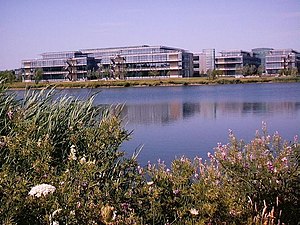Los Angeles, Ca (PRWEB) September 18, 2012
LA commercial real estate is what makes LA real estate so desirable among investors. Every property makes a contribution to the overall feel and vibe of the entire community. Red Blue Realty presents these terms that every investor should know.
(1) Net Operating Income (NOI):
The net operating income of a property is at the top of the list for importance by investors. Each model and investment decision is reliant upon an accurate value for the net operating income. The NOI is determined by taking the annual gross income and subtracting the operating expenses of a property. The gross income is simply the aggregate amounts of all income generated by the property. The operating expenses are the total expenses incurred during the operations and maintenance of the property.
| (Photo credit: Wikipedia) |
Arguably one of the most important terms of commercial real estate in Los Angeles is the capitalization rate or “cap rate”. Investors use the capitalization rate to determine the value of their investment --assuming they paid cash-- by providing a numerical measure of the properties performance. The cap rate is determined by taking the annual net operating income and dividing it by the cost/purchase price of the property.
(3) Cash Flow:
Cash flow is simply the amount of cash that is flowing to an investment. When a landlord rents out a property to a tenant, the monthly rent check is then considered part of the properties cash flow. The ideal investment would have a positive cash flow, which means a property is producing more income than the expenses it requires. Often times a bank will do a cash flow analysis on a property to determine if they are willing to lend money to an investor.
(4) Cash-On-Cash Rate:
The cash-on-cash rate is a measure of the return in accordance with the actual cash investment. Often times LA investors will purchase a property through various financing methods rather then paying for it with all cash. To determine the cash-on-cash rate one must take the annual income of a property and divide it by the cash investment For example, an investor may put forth 25% of their own cash and finance the additional 75% of the remaining balance to acquire a property. The cash-on-cash rate would measure the return of the 25% investment that is made rather then the entire 100%.
(5) Gross Rent Multiplier (GRM):
The gross rent multiplier is a measure of a properties value. Although investors use the GRM model for the same purpose as the cap rate formula--it is definitely not the same. GRM is a ratio of the sale price of an income property divided by the annual gross income. The majority of investors will use the gross rent multiplier to determine if a property is priced correctly before continuing with their due diligence. It is not recommended to make an investment decision solely based on the GRM because it assumes there are no vacancies, and does not factor in expenses. After calculating the GRM on an income property, an investor may see a small or large number. Although each investment strategy will vary, an investor will typically seek a lower GRM to produce a positive cash flow.
With so many small details that are involved with investing in commercial real estate, it is extremely important to have a LA real estate agent that is knowledgeable, experienced, and aimed at providing the best results. Red Blue Realty is the firm that has the capabilities to get you the most for your money--and they don’t settle for less.
Website: http://www.redbluerealty.com
Email: Contact(at)redbluerealty(dot)com
Phone Number: 1 - (855) 66-RBREALTY or 1- (855) 667-2732
Taken from: http://www.prweb.com/releases/Commercial-real-estate-LA/LA-real-estate/prweb9914201.htm






No comments:
Post a Comment